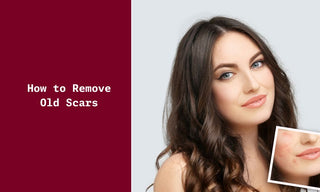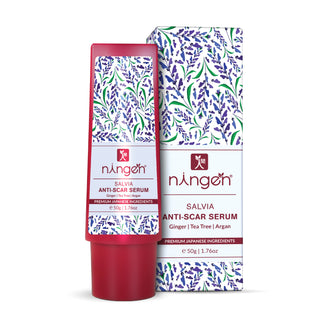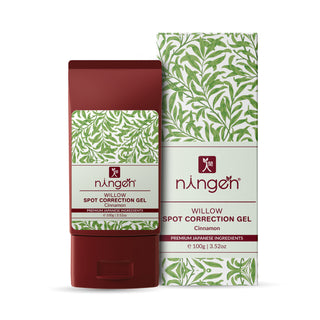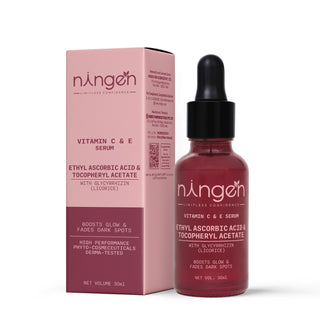"Scars remind us that the past is real." - Cormac McCarthy
Scars are a natural part of the healing process, but old scars can sometimes be a bother. Whether they are from acne, cuts, or surgery, scars can affect your confidence and how you feel about your appearance. The good news is that there are several ways to help reduce the appearance of old scars. This blog will share 11 top tips for removing old scars. These tips are easy to follow and can make a big difference in how your skin looks and feels.
So, let's get started on the journey to smoother, clearer skin!
In This Article;
- What Are Scars?
- Types of Scars
- How Do Scars Form?
- 11 Tips to Remove Old Scars
- Lifestyle and DIY Approaches
- The Bottom Line
- TL;DR(Too Long ; Didn't Read)
- Frequently Asked Questions
What Are Scars?
get a bad burn, your body works to fix the damage. As it heals, it makes new skin to cover the wound. Sometimes, this new skin looks different from the rest of your skin, and that's what we call a scar.
Scars can be different shapes, sizes, and colors. They might be flat, raised, or sunken. Some scars fade over time and become less noticeable, while others might stay the same. They are a natural part of the healing process, but with proper care, you can help them look better and feel more comfortable.
Types of Scars
Scars are a natural part of the body's healing process, yet their appearance can vary greatly depending on numerous factors including the type of scar, skin type, and the severity of the initial wound. Here are the main types of scars:
- Atrophic Scars: These scars create a depression in the skin and are commonly associated with acne or chickenpox.
- Hypertrophic Scars: Thick, raised, and red in color, these scars remain within the initial wound's boundaries.
- Keloid Scars: Similar to hypertrophic scars but often extend beyond the original injury site. They may also impair movement due to their tight, shiny skin surface.
- Contracture Scars: Resulting from burns, these scars cause the skin to tighten, potentially affecting underlying muscles and tendons, limiting mobility.
Each scar type may respond differently to treatment options like laser therapy, silicone gel sheets, or surgical procedures. It’s important to consult with a professional to determine the most suitable treatment for your scar type and skin condition. Natural remedies and over-the-counter products may offer relief and aid in the appearance of scars, but professional treatments are recommended for severe scars. Always consider scientific evidence when evaluating treatment options for effectiveness and safety.
Scar Types & Recommended Treatments:
|
Type of Scar |
Recommended Treatment |
|
Hypertrophic |
Steroid injections, laser therapy |
|
Keloid |
Surgical removal, silicone sheets |
|
Atrophic |
Dermal fillers, laser treatments |
|
Contracture |
Skin grafts, surgery |
|
Acne Scars |
Chemical peels, laser therapy |
How Do Scars Form?
Scars form as part of your body's natural healing process. Here's how it happens:
- Injury: When you get a cut, burn, or other injury, your skin gets damaged.
- Body's Response: Your body immediately starts to fix the damage. It sends special cells to the injured area to clean it up and fight any germs.
- New Skin: The body makes new skin to cover the wound. This new skin is made of a protein called collagen.
- Scar Formation: The new skin isn't the same as your original skin. It might be thicker, tougher, or a different color. This is what we see as a scar.
- Healing Time: Over time, scars can change. They might become flatter, softer, and less noticeable but usually don't disappear completely.
11 Tips to Remove Old Scars
Removing old scars can be challenging, but with patience and the right approach, you can significantly reduce their appearance. Here are 11 tips to help you manage and minimize old scars:
- Silicone Gel or Sheets: Use silicone gel or sheets to cover the scar. These can help flatten and fade scars over time.
- Hydrate with Moisturizers: Apply moisturizers regularly to keep the scar tissue soft and hydrated, which can improve its appearance.
- Massage the Scar: Gently massage the scar for a few minutes daily. This can help break down the dense scar tissue and improve blood flow.
- Exfoliate Regularly: Use gentle exfoliation methods to remove dead skin cells around the scar. This can help promote new skin growth and improve texture.
- Use Sunscreen: Protect the scar from the sun by applying sunscreen. UV rays can darken scars and make them more noticeable.
- Over-the-counter Creams: Apply over-the-counter creams that contain ingredients like vitamin E, onion extract, or aloe vera to help reduce scar appearance.
- Laser Therapy: Consider laser treatments, which can reduce the thickness, color, and texture of scars. Consult with a dermatologist for this option.
- Chemical Peels: Chemical peels can remove the top layer of skin, reducing the appearance of scars. This should be done by a professional.
- Microneedling: Microneedling involves tiny needles that create small punctures in the skin, promoting collagen production and improving scar texture.
- Home Remedies: Natural remedies like honey, coconut oil, or lemon juice can be applied to scars. They have moisturizing and healing properties that might help fade scars.
- Professional Treatments: Consult a dermatologist for professional treatments like steroid injections, dermabrasion, or surgical revision to improve stubborn scars.
Remember, while these tips can help reduce the appearance of old scars, results vary from person to person. Be patient and consistent with your chosen method, and seek professional advice for the best outcomes.

Note: Click on the link to know about chemical peel and its removal of skin spots.
Proper Skincare Routine for Removing Old Scars
A consistent skincare routine can support scar reduction alongside other treatment modalities. Here's a simplified skincare regimen aimed at improving scarring:
- Cleansing: Use a gentle, non-abrasive cleanser to maintain clean skin and prevent further irritation.
- Moisturizing: Hydrate the skin with a quality moisturizer to maintain its elasticity and barrier function.
- Exfoliating: Employ mild exfoliation to remove dead skin and promote new cell growth. This should be done sparingly to avoid exacerbating the scar.
- Sun protection: Apply a broad-spectrum sunscreen with SPF 30 or higher to prevent darkening of the scar tissue.
Each step should be done with care, and the products used should be suitable for your skin type and the condition of the scar.
Topical Treatments for Old Scars
Topical treatments for old scars offer a non-invasive way to improve their appearance. These include over-the-counter creams, gels, and prescription medications that hydrate the skin, improve texture, and support healing. Consistency and patience are key, as improvements can take several months.
Silicone Gel Sheets:
Effective for hypertrophic scars and keloids, silicone gel sheets create a protective layer that maintains hydration and normalizes scar tissue. Wear them for several hours daily over months for best results.
Petroleum Jelly:
Affordable and accessible, petroleum jelly keeps the wound environment moist, which can minimize scar formation. It's more effective for fresh wounds but can help old scars by keeping the skin moisturized.
Natural Remedies:
Home-based treatments like onion extract, essential oils (lavender and rosehip), and aloe vera are popular for their anti-inflammatory and skin-regenerating properties. While less aggressive than medical procedures, they can provide subtle improvements, particularly for less severe scars.
When using topical treatments, monitor your skin for adverse reactions, especially if you have sensitive skin or allergies. For the best results tailored to your skin type and scar specifics, consult a healthcare professional.
Professional Treatment Options for Old Scars
Professional treatments provide intensive options to reduce old scars, administered by dermatologists. The choice of treatment depends on the scar type, severity, skin type, and healing patterns. Options include laser therapy, dermal fillers, and surgical procedures, each with unique risks, recovery times, and effectiveness. Consultation with a healthcare professional is essential.
Laser Therapy
Laser therapy uses concentrated light to improve scar appearance by encouraging new skin growth.

Types include:
Ablative Laser Resurfacing: Removes the top skin layer.
Non-Ablative Laser Therapy: Stimulates collagen without damaging the outer skin.
Fractional Laser Therapy: Creates micro-wounds to promote healing.
Recovery may involve temporary redness, swelling, and discomfort.
Dermal Fillers
Dermal fillers are injected to raise depressed scars, effective for atrophic scars from acne or chickenpox. Common fillers include:
Hyaluronic Acid: Adds volume.
Poly-L-lactic Acid (PLLA): Stimulates collagen.
Calcium Hydroxylapatite: Enhances skin texture.
Regular treatments are necessary to maintain effects, with the potential for allergic reactions or uneven textures.
Surgical Procedures
Surgical scar revision alters scar size, depth, or color, suitable for prominent scars. Techniques include:
Excision: Removing scar tissue.
Skin Grafts: Transplanting skin from another body area.
Z-plasty: Aligning scar tissue with natural skin folds.
Tissue Expansion: Using a balloon to grow extra skin.
Surgical procedures carry risks like infection and require thorough pre-and post-operative care.
Lifestyle and DIY Approaches
Improving the appearance of old scars can also be achieved through various lifestyle adjustments and DIY methods. Although these approaches may not yield results as dramatic as professional treatments, they can still contribute to less noticeable scars over time.
|
Lifestyle Adjustments |
DIY Methods |
|
Maintaining a balanced diet |
Applying natural remedies |
|
Ensuring adequate hydration |
Massaging the scar area |
|
Avoiding cigarette smoking |
Using over-the-counter scar creams |
|
Protecting scars from the sun |
Creating homemade exfoliation treatments |
How Does Diet Help To Remove Old Scars?
Diet plays a pivotal role in skin health, and consuming collagen-rich foods can support the body’s natural healing processes and potentially improve the appearance of scars.
|
Collagen-Rich Foods |
Benefits |
|
Bone broth |
Provides essential amino acids |
|
Fish and lean meats |
Supplies high-quality protein |
|
Dairy products |
Contains necessary nutrients |
|
Eggs |
Offers both protein and vitamin D |
|
Berries, citrus fruits, and vegetables |
Loaded with antioxidants and vitamins |
These foods provide the building blocks needed for collagen production—a protein that aids the repair of skin tissues. While diet alone may not remove scars, it can improve overall skin health and serve as a complementary approach to professional scar treatments.
Proper Wound Care Helps In Easy Removal Of Scars
To minimize the formation of prominent scars, practicing proper wound care from the beginning is crucial. Following healthy healing practices can make a significant difference in the final appearance of scars.
- Clean the wound with mild soap and cool water.
- Keep the wound moist with petroleum jelly to prevent a scab from forming.
- Cover the wound with an adhesive bandage or sterile gauze to protect it from bacteria and irritation.
- Change the bandage daily to keep the wound clean.
Adhering to these steps not only promotes quicker healing but also helps ensure the skin regenerates with as little scarring as possible. Avoid picking at the scab or scratching the area, as this can increase the risk of further scarring or infection.
Prevention and Care for Fresh Scars
To minimize scarring, proactive steps during early wound healing are essential. Proper initial care, UV protection, and avoiding irritants can greatly improve scar appearance.
Prompt Wound Care
- Clean the wound with mild soap and cool water to remove debris and bacteria.
- Apply a thin layer of petroleum jelly to keep the area moist and promote healing.
- Cover with sterile gauze or an adhesive bandage to prevent contamination.
- Change the dressing daily or when it becomes damp or dirty to maintain a clean healing environment.
Minimizing Sun Exposure
- Apply a broad-spectrum sunscreen with at least SPF 30 on the scar if exposed to the sun.
- Cover the scar with clothing or a bandage, especially during peak sunlight hours.
- Seek shade to limit UV radiation exposure, preventing pigmentation issues that can make scars more noticeable.
Avoiding Aggravating Factors
- Avoid picking or scratching the scab or scar to prevent further damage and infection.
- Refrain from smoking, as it impedes blood flow and slows healing.
- Manage stress to support your body's healing processes.
- Maintain a nutritious diet to aid wound healing.
Is Natural Removal of Scars Possible?
Yes, natural methods can help improve the appearance of scars, making them less noticeable over time. While completely removing scars naturally can be challenging, consistent use of certain natural ingredients and remedies can significantly reduce their visibility. Here are some effective methods and natural ingredients that can aid in the process:
1. Aloe Vera
- Properties: Soothing, anti-inflammatory, and moisturizing.
- Method: Apply fresh aloe vera gel directly to the scar, leave it on for 30 minutes, and rinse off with cool water. Repeat twice daily.
2. Honey
- Properties: Moisturizing, antibacterial.
- Method: Apply raw honey to the scar, cover with a bandage, leave overnight, and wash off in the morning. Repeat nightly.
3. Coconut Oil
- Properties: Rich in fatty acids, promotes skin regeneration.
- Method: Warm coconut oil until it liquefies, massage into the scar for 10 minutes, leave on for at least an hour, and repeat 2-4 times daily.
4. Lemon Juice
- Properties: Natural bleaching agent, promotes skin lightening.
- Method: Apply lemon juice to the scar with a cotton ball, leave on for 10 minutes, and rinse off with cool water. Repeat once daily, and apply sunscreen afterward.
5. Olive Oil
- Properties: Rich in vitamins and antioxidants.
- Method: Massage extra virgin olive oil into the scar for 5 minutes, leave on for 30 minutes or overnight, and rinse with warm water. Repeat daily.
6. Baking Soda
- Properties: Exfoliates and removes dead skin cells.
- Method: Mix baking soda with water to make a paste, apply to the scar, leave for 15 minutes, and rinse off. Repeat twice a week.
7. Onion Extract
- Properties: Anti-inflammatory, improves skin texture.
- Method: Apply onion extract gel to the scar, let it dry, and repeat daily for several weeks.
8. Vitamin E
- Properties: Antioxidant, promotes skin healing.
- Method: Break open a vitamin E capsule, apply the oil to the scar, massage for 10 minutes, leave on for 20 minutes, and rinse off. Repeat daily.
9. Apple Cider Vinegar
- Properties: Exfoliating, promotes skin cell turnover.
- Method: Dilute with water (1:2 ratio), apply to the scar with a cotton ball, leave for 10 minutes, and rinse off. Repeat daily.
10. Tea Tree Oil
- Properties: Antiseptic, anti-inflammatory.
- Method: Dilute with a carrier oil, apply to the scar, leave on for several hours or overnight, and rinse off if needed. Repeat daily.
11. Cucumber
- Properties: Soothing, lightening.
- Method: Blend cucumber into a paste, apply to the scar, leave for 30 minutes, and rinse off. Repeat daily.
Additional Tips for Natural Scar Reduction(highlight)
- Hydration: Drink plenty of water to keep your skin hydrated and healthy.
- Nutrition: Eat a balanced diet rich in vitamins and minerals to support skin repair and regeneration.
- Avoid Sun Exposure: Protect scars from the sun with sunscreen or clothing, as UV exposure can darken scars.
Check out our curated selection of anti-scar skincare below.
The Bottom Line
Hope you found this article on how to remove old scars helpful. While scars are a natural part of the healing process, there are many methods to help reduce their appearance and improve your skin's texture. Whether you choose natural remedies, over-the-counter treatments, or professional procedures, consistent care and patience are key. These tips and treatments apply to scars on the face, hands, legs, and any other part of the body. Always consider consulting with a healthcare professional for the best advice tailored to your specific needs and skin type.
"Every scar tells a story, but with proper care, they can become quieter whispers of the past."
Quick view
Scars can be improved with natural remedies, topical treatments, and professional procedures. Effective natural methods include aloe vera, honey, coconut oil, and lemon juice. Over-the-counter options like silicone gel sheets and professional treatments like laser therapy can also help. Proper wound care, sun protection, and lifestyle adjustments are crucial. These methods apply to scars on the face, hands, legs, and any part of the body. Consistency and patience are key to achieving the best results.
Frequently Asked Questions
Q1. Can old scars really be removed naturally?
While completely removing old scars naturally is challenging, consistent use of natural remedies such as aloe vera, honey, and coconut oil can significantly reduce their appearance over time.
Q2. What are the most effective natural remedies for scar reduction?
Some effective natural remedies include aloe vera, honey, coconut oil, lemon juice, olive oil, baking soda, onion extract, vitamin E, apple cider vinegar, and tea tree oil.
Q3. How long does it take for natural remedies to show results on scars?
Results can vary depending on the scar's age and severity. Generally, noticeable improvements can take several weeks to a few months of consistent application.
Q4. Can these treatments be used on any part of the body?
Yes, the mentioned treatments can be applied to scars on the face, hands, legs, and any other part of the body. Always do a patch test to ensure you don't have an allergic reaction.
Q5. Is it necessary to consult a dermatologist before trying natural remedies?
While natural remedies are generally safe, consulting a dermatologist is recommended, especially if you have sensitive skin, allergies, or severe scars, to ensure the chosen method is suitable for you.
Q6. Do over-the-counter scar creams really work?
Over-the-counter scar creams with ingredients like silicone, vitamin E, and onion extract can help reduce scar appearance. Effectiveness varies, so consistency and patience are key.
Q7. What professional treatments are available for old scars?
Professional treatments include laser therapy, dermal fillers, surgical procedures, and chemical peels. These treatments can offer more significant improvements but should be discussed with a healthcare professional.
Q8. How important is sun protection for scar healing?
Sun protection is crucial as UV exposure can darken scars and make them more noticeable. Always use a broad-spectrum sunscreen with at least SPF 30 on scars exposed to sunlight.
Q9. What role does diet play in scar healing?
A balanced diet rich in collagen-boosting foods (e.g., bone broth, fish, lean meats) and antioxidants (e.g., berries, citrus fruits) supports the body's natural healing processes and can improve overall skin health.
Q10. How can I prevent new scars from forming?
Proper wound care, such as cleaning the wound, keeping it moist with petroleum jelly, covering it with a sterile bandage, and avoiding picking or scratching, can help minimize scar formation.
Q 11: What are the fastest ways to fade old scars?
The fastest ways to fade old scars involve a combination of treatments. Use silicone gel or sheets to hydrate and flatten scars, apply moisturizers to keep scar tissue soft, and massage scars daily to improve blood flow and break down dense tissue. Exfoliating regularly can also help by removing dead skin cells and promoting new skin growth. Lastly, protect scars from the sun with sunscreen to prevent them from becoming darker and more noticeable.
Q12. Can Scars Be Removed Permanently?
Yes and no. Scars cannot be completely removed in the sense of returning the skin to its original, pre-injury state. However, various treatments can significantly reduce the appearance of scars, making them less noticeable.











